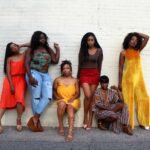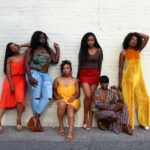Introduction to the concept of fashion icons
Fashion is more than just clothing; it’s a powerful form of self-expression and identity. Throughout history, certain figures have emerged as fashion icons, influencing trends and shaping cultural narratives. These style mavens not only redefine what it means to be fashionable but also leave an indelible mark on the world.
Join us on a journey through time as we explore the remarkable lives and styles of these influential figures. From the daring flappers of the 1920s to today’s bold trendsetters, let’s delve into how their unique looks continue to inspire generations. Get ready to appreciate timeless elegance, rebellion against norms, and diverse representations that make fashion what it is today!
Fashion icons of the 1920s: Coco Chanel and the Flapper style
The 1920s marked a revolutionary shift in fashion, led by the indomitable Coco Chanel. She shattered conventions with her daring designs and bold ideas.
Chanel introduced the world to comfortable elegance. Her creation of the little black dress transformed women’s wardrobes forever. It symbolized freedom and sophistication, allowing women to express their individuality.
This era also birthed the Flapper style. Young women embraced a new sense of independence through shorter hemlines, bobbed hair, and vibrant accessories. They danced the Charleston in jazz clubs, radiating confidence and rebellion.
Coco’s influence extended beyond clothing; she redefined femininity itself. The blend of simplicity and luxury became her hallmark, making high fashion accessible for many.
As flappers sipped cocktails at speakeasies, they embodied modernity’s spirit—a celebration of youthfulness that still resonates today.
The 1950s: Audrey Hepburn and the timeless elegance of the Little Black Dress
The 1950s marked a transformative era in fashion, largely influenced by the enchanting Audrey Hepburn. With her striking features and effortless charm, she redefined elegance on screen and off.
Central to her iconic style was the Little Black Dress. Designed by Hubert de Givenchy for “Breakfast at Tiffany’s,” this piece became synonymous with sophistication. Its simplicity allowed Hepburn’s grace to shine through.
Beyond just a dress, it symbolized empowerment for women of the time. No longer just a garment, it represented freedom and individuality during a decade that celebrated femininity.
Audrey’s ability to blend classic beauty with modern sensibility made her an everlasting muse. She inspired countless designers and shaped trends that resonate even today. Her legacy continues as women worldwide embrace the timeless allure of black dresses, channeling their inner Hepburn with each wear.
The 1970s: Cher and her iconic bohemian style
The 1970s were a vibrant explosion of color, music, and cultural revolution. Cher emerged as a prominent figure during this era, captivating audiences with her unique bohemian style.
Her wardrobe was an eclectic mix of flowing fabrics, intricate patterns, and bold accessories. From feathered headpieces to mesmerizing bell-bottoms, she effortlessly embodied the spirit of freedom and individuality that defined the decade.
Cher wasn’t just a singer; she was a trendsetter. Her daring looks challenged conventional fashion norms. She embraced both femininity and strength in ways that inspired countless fans.
Every appearance on stage or screen showcased her flair for drama—whether it was sequined gowns or layered ensembles adorned with fringe.
This fearless approach resonated deeply within popular culture, making Cher an enduring symbol of 1970s fashion innovation. Her influence is still felt today as new generations revisit those whimsical styles.
The 1990s: Kate Moss and the rise of grunge fashion
The 1990s marked a dramatic shift in fashion, with Kate Moss at the forefront of this revolution. Her ethereal look and effortless style captured the zeitgeist of the decade.
Moss became synonymous with grunge—a counterculture movement that celebrated individuality over traditional beauty. Think oversized flannel shirts, ripped jeans, and combat boots paired with an understated attitude.
Her influence stretched beyond clothing; she embodied a carefree spirit that resonated deeply with youth culture. She challenged conventional standards of glamour by embracing imperfections and authenticity.
This era also highlighted a fusion between high fashion and street style. Designers started to incorporate elements of grunge into their collections, paving the way for daring trends that still echo today.
Kate’s unique blend of edginess and elegance left an indelible mark on both runway shows and everyday wardrobes alike—a true reflection of her time.
Modern-day fashion icons: Rihanna, Beyoncé, and their impact on diversity
Modern-day fashion icons like Rihanna and Beyoncé have reshaped the landscape of style. Their influence goes beyond just clothing; they challenge traditional standards of beauty and promote diversity in fashion.
Rihanna, with her bold choices and fearless experimentation, has become a force to be reckoned with. Her brand, Fenty Beauty, revolutionized the makeup industry by offering an extensive range of shades for all skin tones. She uses her platform to advocate for inclusivity while showcasing unique looks that resonate with different cultures.
Beyoncé embodies power and elegance. She embraces her heritage through fashion while pushing boundaries with daring ensembles. Whether on stage or at high-profile events, she consistently delivers standout moments that inspire countless fans around the globe.
Together, these women are redefining what it means to be a fashion icon in today’s world. They not only set trends but also create space for authentic representation within the industry. As we look back on these influential figures throughout history, it’s evident that their legacies continue to shape our understanding of style and individuality across generations.


